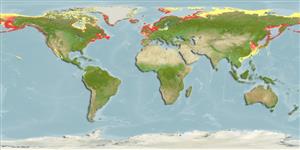Bivalvia |
Myida |
Myidae
Environment: milieu / climate zone / depth range / distribution range
Ecology
Benthic; depth range 2 - 100 m (Ref. 83435). Temperate; 84°N - 34°N, 180°W - 180°E
Arctic, Northern Atlantic and Northern Pacific.
Length at first maturity / Size / Weight / Age
Maturity: Lm ? range ? - ? cm Max length : 8.0 cm SHL male/unsexed; (Ref. 95344)
Maximum depth from Ref. 95344. Suspension feeder; burrows at considerable depths in mixed sand, sandy mud, or gravel substrata from the lower shore to about 70 m (Ref. 3477). Main food is based on another species of the same Genus; to be replaced with a better reference (Ref. 95774).
Life cycle and mating behavior
Maturity | Reproduction | Spawning | Eggs | Fecundity | Larvae
Members of the class Bivalvia are mostly gonochoric, some are protandric hermaphrodites. Life cycle: Embryos develop into free-swimming trocophore larvae, succeeded by the bivalve veliger, resembling a miniature clam.
Piepenburg, D., N.V. Chernova, C.F. von Dorrien, J. Gutt, A.V. Neyelov, E. Rachor, L. Saldanha and M.K. Schmid 1996 Megabenthic communities in the waters around Svalbard. Polar Biol. 16:431-446. (Ref. 2952)
IUCN Red List Status
(Ref. 130435: Version 2025-1)
CITES status (Ref. 108899)
Not Evaluated
Not Evaluated
Threat to humans
Human uses
| FishSource |
Tools
More information
Trophic EcologyFood items (preys)Diet compositionFood consumptionPredators Life cycleReproductionMaturityFecunditySpawningEggsEgg developmentLarvae PhysiologyOxygen consumption
Human RelatedStamps, coins, misc.
Internet sources
Estimates based on models
Preferred temperature
(Ref.
115969): 0.6 - 13.3, mean 5 (based on 2454 cells).
Resilience
Low, minimum population doubling time 4.5 - 14 years (K=0.08).
Fishing Vulnerability
Moderate to high vulnerability (46 of 100).
Price category
Unknown.
